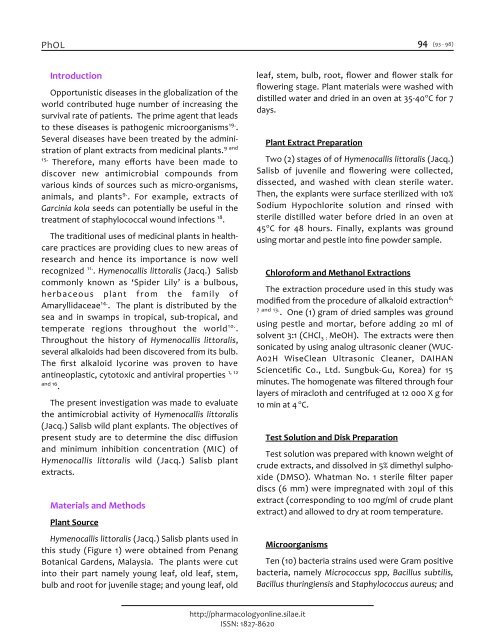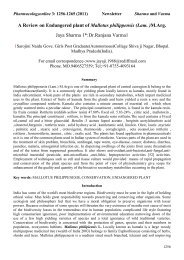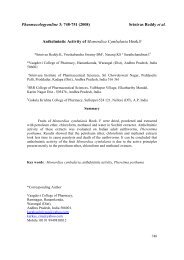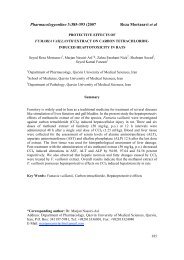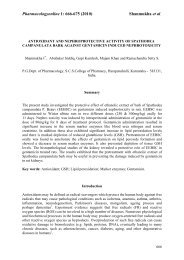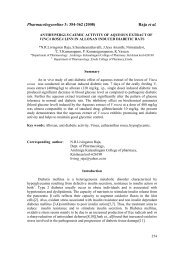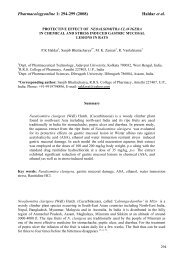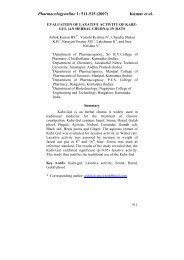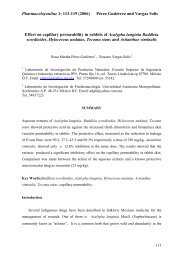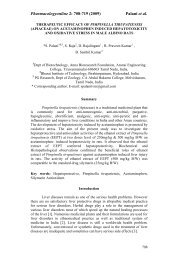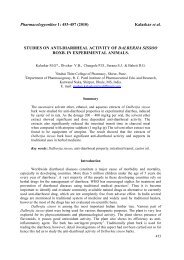Screening of potential antimicrobial activity from Hymenocallis littoralis
Screening of potential antimicrobial activity from Hymenocallis littoralis
Screening of potential antimicrobial activity from Hymenocallis littoralis
Create successful ePaper yourself
Turn your PDF publications into a flip-book with our unique Google optimized e-Paper software.
PhOL<br />
Introduction<br />
Opportunistic diseases in the globalization <strong>of</strong> the<br />
world contributed huge number <strong>of</strong> increasing the<br />
survival rate <strong>of</strong> patients. The prime agent that leads<br />
to these diseases is pathogenic microorganisms 19. .<br />
Several diseases have been treated by the admini-<br />
9 and<br />
stration <strong>of</strong> plant extracts <strong>from</strong> medicinal plants.<br />
15. Therefore, many efforts have been made to<br />
discover new <strong>antimicrobial</strong> compounds <strong>from</strong><br />
various kinds <strong>of</strong> sources such as micro-organisms,<br />
animals, and plants 9. . For example, extracts <strong>of</strong><br />
Garcinia kola seeds can <strong>potential</strong>ly be useful in the<br />
treatment <strong>of</strong> staphylococcal wound infections 18 .<br />
The traditional uses <strong>of</strong> medicinal plants in healthcare<br />
practices are providing clues to new areas <strong>of</strong><br />
research and hence its importance is now well<br />
recognized 11. . <strong>Hymenocallis</strong> <strong>littoralis</strong> (Jacq.) Salisb<br />
commonly known as ‘Spider Lily’ is a bulbous,<br />
herbaceous plant <strong>from</strong> the family <strong>of</strong><br />
Amaryllidaceae14. . The plant is distributed by the<br />
sea and in swamps in tropical, sub-tropical, and<br />
10.<br />
temperate regions throughout the world .<br />
Throughout the history <strong>of</strong> <strong>Hymenocallis</strong> <strong>littoralis</strong>,<br />
several alkaloids had been discovered <strong>from</strong> its bulb.<br />
The first alkaloid lycorine was proven to have<br />
1, 12<br />
antineoplastic, cytotoxic and antiviral properties<br />
and 16 .<br />
The present investigation was made to evaluate<br />
the <strong>antimicrobial</strong> <strong>activity</strong> <strong>of</strong> <strong>Hymenocallis</strong> <strong>littoralis</strong><br />
(Jacq.) Salisb wild plant explants. The objectives <strong>of</strong><br />
present study are to determine the disc diffusion<br />
and minimum inhibition concentration (MIC) <strong>of</strong><br />
<strong>Hymenocallis</strong> <strong>littoralis</strong> wild (Jacq.) Salisb plant<br />
extracts.<br />
Materials and Methods<br />
Plant Source<br />
<strong>Hymenocallis</strong> <strong>littoralis</strong> (Jacq.) Salisb plants used in<br />
this study (Figure 1) were obtained <strong>from</strong> Penang<br />
Botanical Gardens, Malaysia. The plants were cut<br />
into their part namely young leaf, old leaf, stem,<br />
bulb and root for juvenile stage; and young leaf, old<br />
http://pharmacologyonline.silae.it<br />
ISSN: 1827-8620<br />
94 (93 - 98)<br />
leaf, stem, bulb, root, flower and flower stalk for<br />
flowering stage. Plant materials were washed with<br />
distilled water and dried in an oven at 35-40 o C for 7<br />
days.<br />
Plant Extract Preparation<br />
Two (2) stages <strong>of</strong> <strong>of</strong> <strong>Hymenocallis</strong> <strong>littoralis</strong> (Jacq.)<br />
Salisb <strong>of</strong> juvenile and flowering were collected,<br />
dissected, and washed with clean sterile water.<br />
Then, the explants were surface sterilized with 10%<br />
Sodium Hypochlorite solution and rinsed with<br />
sterile distilled water before dried in an oven at<br />
45 o C for 48 hours. Finally, explants was ground<br />
using mortar and pestle into fine powder sample.<br />
Chlor<strong>of</strong>orm and Methanol Extractions<br />
The extraction procedure used in this study was<br />
modified <strong>from</strong> the procedure <strong>of</strong> alkaloid extraction 6,<br />
7 and 13. . One (1) gram <strong>of</strong> dried samples was ground<br />
using pestle and mortar, before adding 20 ml <strong>of</strong><br />
solvent 3:1 (CHCl 3 : MeOH). The extracts were then<br />
sonicated by using analog ultrasonic cleaner (WUC-<br />
A02H WiseClean Ultrasonic Cleaner, DAIHAN<br />
Sciencetific Co., Ltd. Sungbuk-Gu, Korea) for 15<br />
minutes. The homogenate was filtered through four<br />
layers <strong>of</strong> miracloth and centrifuged at 12 000 X g for<br />
10 min at 4 o C.<br />
Test Solution and Disk Preparation<br />
Test solution was prepared with known weight <strong>of</strong><br />
crude extracts, and dissolved in 5% dimethyl sulphoxide<br />
(DMSO). Whatman No. 1 sterile filter paper<br />
discs (6 mm) were impregnated with 20µl <strong>of</strong> this<br />
extract (corresponding to 100 mg/ml <strong>of</strong> crude plant<br />
extract) and allowed to dry at room temperature.<br />
Microorganisms<br />
Ten (10) bacteria strains used were Gram positive<br />
bacteria, namely Micrococcus spp, Bacillus subtilis,<br />
Bacillus thuringiensis and Staphylococcus aureus; and


